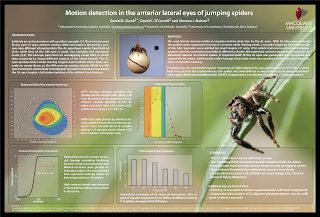Wednesday, October 23, 2013
Friday, March 30, 2012
New spider paper out
Our new paper on saccadic tracking of targets by jumping spiders is now available online, on the J Comp Physiol A website.
Zurek DB and Nelson XJ (2012) Saccadic tracking of targets mediated by the anterior-lateral eyes of jumping spiders. J Comp Physiol A, DOI: 10.1007/s00359-012-0719-0
The modular visual system of jumping spiders (Salticidae) divides characteristics such as high spatial acuity and wide-field motion detection between different pairs of eyes. A large pair of telescope-like anterior-median (AM) eyes is supported by 2–3 pairs of ‘secondary’ eyes, which provide almost 360 degrees of visual coverage at lower resolution. The AM retinae are moveable and can be pointed at stimuli within their range of motion, but salticids have to turn to bring targets into this frontal zone in the first place. We describe how the front-facing pair of secondary eyes (anterior lateral, AL) mediates this through a series of whole-body ‘tracking saccades’ in response to computer-generated stimuli. We investigated the ‘response area’ of the AL eyes and show a clear correspondence between the physical margins of the retina and stimulus position at the onset of the first saccade. Saccade frequency is maximal at the margin of AL and AM fields of view. Furthermore, spiders markedly increase the velocity with which higher magnitude tracking saccades are carried out. This has the effect that the time during which vision is impaired due to motion blur is kept at an almost constant low level, even during saccades of large magnitude.
Zurek DB and Nelson XJ (2012) Saccadic tracking of targets mediated by the anterior-lateral eyes of jumping spiders. J Comp Physiol A, DOI: 10.1007/s00359-012-0719-0
The modular visual system of jumping spiders (Salticidae) divides characteristics such as high spatial acuity and wide-field motion detection between different pairs of eyes. A large pair of telescope-like anterior-median (AM) eyes is supported by 2–3 pairs of ‘secondary’ eyes, which provide almost 360 degrees of visual coverage at lower resolution. The AM retinae are moveable and can be pointed at stimuli within their range of motion, but salticids have to turn to bring targets into this frontal zone in the first place. We describe how the front-facing pair of secondary eyes (anterior lateral, AL) mediates this through a series of whole-body ‘tracking saccades’ in response to computer-generated stimuli. We investigated the ‘response area’ of the AL eyes and show a clear correspondence between the physical margins of the retina and stimulus position at the onset of the first saccade. Saccade frequency is maximal at the margin of AL and AM fields of view. Furthermore, spiders markedly increase the velocity with which higher magnitude tracking saccades are carried out. This has the effect that the time during which vision is impaired due to motion blur is kept at an almost constant low level, even during saccades of large magnitude.
Sunday, September 25, 2011
Student volunteer project available!
I have a cool project for interested students at Macquarie (or from anywhere, really). The aim of this experiment is to find out ways to trick male jumping spiders into displaying aggressive or mating displays, using artificial stimuli. This will add to our knowledge about the various sensory modes involved in jumping spider communication.
Here's some general info:
Skills you will learn: Finding jumping spiders in the field (they're everywhere around MQ), designing experimental protocols, running experiments, working with video, analysing behavioural data. The framework for the experiment is in place, but it is still flexible so you will have room to be creative. The project will take a few weeks, depending on how much time you can put in. Just be aware that this is meant to be a full project from beginning to end, with the possibility of co-authoring a publication once it's done. No previous experience is needed, but as this is a complete research project you should have good organisational skills and be able to work independently to a degree. Bonus if you're comfortable with handling video equipment + software.
If you're interested or have any questions, please contact me at daniel.zurek@mq.edu.au.
Thursday, July 21, 2011
Neuroethology poster
Just got my posters printed, I decided to go landscape this time - the photo with the curious spider was just too tempting. Here is the one for the Gordon Neuroethology conference in mid-August. Five awesome sciency weeks start on sunday!
Sunday, July 3, 2011
Gearing up for conferences
These are the last weeks before my next conference trip, and I'm busy making posters for Behavior '11 and the Gordon Neuroethology meeting. I'm very excited! This week I found some time to take a few new photos of my spiders with the GF-1. I really love this camera, but was a bit unsure about shooting macro with it ... my current setup with a telephoto lens and a clip-on raynox macro converter works okay, but it's extremely hard to get good shots at higher magification. Definitely useable as poster eye candy though :-) But the next investment will definitely be a proper macro lens + flash.
Subscribe to:
Comments (Atom)



